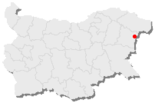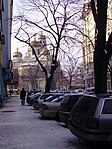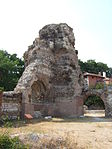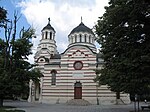Varna
| Varna (Варна) | |||
|
|||
| Basic data | |||
|---|---|---|---|
| State : |
|
||
| Oblast : | Varna | ||
| Residents : | 336,505 (December 31, 2018 ) | ||
| Area : | 154.236 km² | ||
| Population density | 2,181.8 inhabitants / km² | ||
| Coordinates : | 43 ° 13 ' N , 27 ° 55' E | ||
| Height : | 80 m | ||
| Postal code : | 9000-9030 | ||
| Telephone code : | (+359) 052 | ||
| License plate : | B. | ||
| administration | |||
| Mayor : | Ivan Portnich | ||
| Ruling party : | GERB | ||
| Website : | www.varna.bg | ||
Varna [ ˈvarnɐ ] (alternative transliteration Varna , Bulgarian Варна ) is a port city on the Black Sea in Bulgaria and the third largest city in the country after Sofia and Plovdiv . It is the center of the municipality of the same name and the province of Varna as well as the seat of the admiralty of the Bulgarian fleet and the diocese of Varna and Veliky Preslav . The city of Varna is administratively divided into five districts (Rajon).
Varna is the most important transport hub for the northeast of the country. The international airport is the third most important in the country after Sofia and Burgas . Varna has the second largest port in Bulgaria after the port of Burgas and is well connected to the Bulgarian rail and road network. The city was the terminus of the first Bulgarian railway line and the first terminus of the Orient Express .
The proximity to the city of several summer health resorts transforms Varna into a lively tourist center in the summer months. The port city is the cultural center of Northeast Bulgaria and is internationally known for its festivals. The city's archaeological museum also houses the world's oldest gold treasure .
geography
location
Varna is located in northeastern Bulgaria directly on the hilly coast of the Black Sea, which forms the Varna Bay here. The urban area lies at the foot and on the slopes of the Franga plateau ( Frangensko ). Directly south of the city center is the port of the city (today port of Warna East). In the north, the city borders the health resort of Golden Sands with several residential areas . In the west, Varna borders directly on the city of Aksakowo . To the south of the port, connected to the city center by the Asparuchowo Bridge, are the Asparuchowo and Galata districts.
The next big city is Burgas , approx. 120 km south , which can be reached by a mostly two-lane pass road through the Balkan Mountains and to which the drive can take up to three hours by car. The Romanian port city of Constanța is 150 km northeast.
climate
| Varna | ||||||||||||||||||||||||||||||||||||||||||||||||
|---|---|---|---|---|---|---|---|---|---|---|---|---|---|---|---|---|---|---|---|---|---|---|---|---|---|---|---|---|---|---|---|---|---|---|---|---|---|---|---|---|---|---|---|---|---|---|---|---|
| Climate diagram | ||||||||||||||||||||||||||||||||||||||||||||||||
| ||||||||||||||||||||||||||||||||||||||||||||||||
|
Average monthly temperatures and rainfall for Varna
Source: wetterkontor.de
|
|||||||||||||||||||||||||||||||||||||||||||||||||||||||||||||||||||||||||||||||||||||||||||||||||||||||||||||||||||||||||||||||||||||||||||||||||||||||||||||||||||||||||||||||||||||||||||||||||||
history
Surname
The city has had several names in its history. In ancient times it was called Odessos , from 1949 to 1956 Stalin after the Soviet dictator Josef Stalin .
City history
prehistory
Since 1972 the cemetery of Varna was discovered in the west of the city, the settlement of this area in the copper stone age in the 5th millennium BC has been. Known. Numerous gold finds from the Karanowo IV era from the 4th millennium BC were found there. BC, which can now be seen in the Archaeological Museum. These grave and gold finds, which were unearthed by 1991, were a scientific sensation.
Varna was already in the early 5th millennium BC. An important supra-regional trading center. It was there that the old European arable farmers based around the lower Danube were bartered with the Proto-Indo-Europeans from the steppe region north of the Black Sea. Around 4500 BC Chr. Took these cattle nomads , in contrast to the egalitarian social structure of the Danube civilization in a hierarchical lived stratified society, the power in the room Varna. The vertical differentiation of the Varna culture emerges from the grave finds in the necropolis of Varna .
Antiquity
The city, whose earliest origin was in Thracian times, was founded in the 7th century BC. Founded by Greek settlers from Miletus . They gave the city the name Odessos , under which it was known in antiquity and the Middle Ages. On the basis of trade with the Thracians, the Greek polis quickly gained in importance. In the 3rd century BC Was the city of Macedonia and in the 1st century BC Dependent on the Roman Empire ; Crafts (pottery, metalworking) and trade nevertheless developed favorably. Fragments of the Roman thermal baths have been preserved from the 2nd century AD .
From 593-594 the city served as an Eastern Roman winter camp during Maurikios' Balkan campaigns . There was also fighting between the Romans and Slavs in the area .
Early middle ages
A settlement of Slavs probably took place from 615th In 681 the Bulgarian Khan Asparuch captured the city from Byzantium . Its current name, Varna, comes from that era . During the First Bulgarian Empire in the 9th and 10th centuries, Varna was an important center of Christianity . During the Second Bulgarian Empire , in the 13th century, it became a city of handicrafts with an important trading port. There were connections between northern Bulgaria and Constantinople , today's Istanbul , and later with the Republic of Ragusa and the Italian trade republics of Venice and Genoa .
Ottoman Empire
In 1391 armed forces of the Ottoman Empire conquered the city and made it a coastal bastion because of its strategically favorable location. In 1402 and 1413 respectively, the Ottomans gave the city and the entire coast down to Constantinople back to the Byzantine Empire, in order to conquer them again and finally before 1444. On November 10, 1444, the Polish and Hungarian king Władysław (1424–1444), who was nicknamed Warneńczyk ("from Warna"), fell in the vicinity of the city . In the Battle of Varna, the Ottoman troops under the leadership of Sultan Murad II (1404-1451) won against a Polish-Hungarian army.
Modern times
In 1828 the Russian fleet captured the city, but could only hold it for two years. During the Crimean War between 1853 and 1856, Varna played a major role. The city was temporarily occupied by British and French troops in 1854 .
Although Russia and the Ottoman Empire fought several times for Varna in the 18th and 19th centuries, the city experienced an economic boom in the 1830s and 1840s, especially in trade, and became the seat of several consulates of European states. The first railway line in the Ottoman Empire in 1866 connected Varna and Russe on the Danube and thus with Western Europe . It stimulated the development of shipping and light industry. Even after the end of Ottoman rule on July 28, 1878, Varna retained its importance as a port and trading city.
In 1893 the Social Democratic Party was founded in the city and in 1901 there was the first strike of the Varna dockworkers.
During the Second World War there was fighting between Bulgarian partisans and the German Wehrmacht in the city ; Varna was the center of the 10th Army of Operations. On August 8, 1944, Soviet forces and Bulgarian partisans captured the city.
After the fall of the communist government in Sofia on November 10, 1989, democratic conditions began to prevail in Varna as well.
Since 1997, the city has given its name to the Varna Peninsula of Livingston Island in Antarctica. About its ancient name Odessos this applies since 2013 and for the Odessos Buttress , a mountain in Graham Land on the Antarctic Peninsula .
population
Population structure
The last census so far took place in the spring of 2011, which was also the first since Bulgaria joined the European Union. Since it was subject to EU regulations, there was the possibility of not answering questions about ethnic and religious affiliation or about the mother tongue. Only 303,594 citizens of Varna answered the question about ethnicity, of whom 284,738 identified themselves as Bulgarians , 10,028 as Turks , 3,162 as Roma and 3,378 stated another ethnicity.
Population development
The changing population figures partly result from the respective territorial status.
|
|
|
The numbers come from:
- Censuses (¹) or
- Estimates (²)
Economy and Infrastructure
Established businesses
The port and shipyard area now extends along the - northern - "Small Canal" to Lake Prowadijska (Lake Varna), shipping into the lake to the port of Warna-West is almost exclusively through the - southern - "Great Canal" (Channel No. 1). With port areas in Dewnja , Balchik , Lesport and Kawarna , the port of Varna was in the past the largest seaport in the country, where around half of Bulgaria's sea-side cargo handling was handled. Grain , dairy products and livestock are still some of the most important export products today. There is also a large terminal for liquid chemicals operated by Oiltanking Bulgaria AD . Today, however, in addition to the port of Warna-East (in Warna City), only the area in Dewnja (port of Warna-West) belongs to the company Port of Warna and is therefore in second place behind the port of Burgas . Today, mainly transit goods for the Romanian market are handled in the port. After several restructurings and privatizations, the Bulyard shipyard is now owned by the Bulgarian company Industry Holding Bulgaria .
Diesel engines , electrical appliances, metal goods , food and textiles were manufactured in the city until the early 1990s . From 1994 to 1996 the automobile manufacturer Rodacar was based here, a short-lived joint venture between Austin Rover and a Bulgarian trading company.
The tourism contributes a large share of the gross national product of Greater Varna. Most of the hotels are located in the northern suburbs of Sweti Konstantin i Elena (Св.св. Константин и Елена), Golden Sands (Златни пясъци) and Albena (Албена). The construction industry takes 2nd place in terms of economic importance.
traffic
The Varna airport after the airports of Sofia and Burgas the third most important in the country, in the summer season has great significance on charter flights. There are currently only scheduled services to Dortmund , Memmingen , Sofia and Vienna . Overall, there is little traffic in the winter months. The airport was modernized and expanded by the operator Fraport from 2012 to 2013 .
A small airfield on the southern bank of the bay, Varna-Chaika, is used as a military airfield by the Bulgarian Navy . She has her helicopter squadron, Otdelna Morska Eskadrila Vertoleti , stationed here.
Varna is connected to many parts of the country by rail and road connections and by bus routes to the near and far. Continuous motorway connections to Sofia and Burgas have been planned for a long time, but have not yet been implemented.
In spite of the massive - and also very heavily used - traffic relief from a well-developed network of city bus routes, inner-city traffic is constantly increasing, with the chronic lack of parking spaces in particular leading to chaotic conditions.
Education
Varna has several educational institutions. These include the Free University of Varna , the Medical University of Varna , the University of Economics in Varna , the Technical University of Varna, the civil and academy of the Bulgarian Navy and several research institutes for oceanography , fish economy and hydrodynamics, among others . There are also many high schools in the city, including several foreign language high schools where you can learn German, English, French and Spanish. The first foreign language high school in Varna is internationally active. Student exchanges are held every year with some high schools, such as the BG / BRG Klosterneuburg .
Culture and leisure
Attractions
The city center is the Dormition of the Mother of God Cathedral (often also called the Cathedral of Our Lady) from 1896. Not far from it is the seat of the diocese of Varna and Veliky Preslav of the Bulgarian Orthodox Church . The cathedral is a monumental structure with interesting wall paintings and considerable woodwork inside. Near the cathedral is a bazaar and the museum of the marine painter Georgi Welschew (1891–1955) with a collection of 250 pictures. To the south is a park, in the southeast corner of which the Stojan Batschwarow theater and the Varna State Opera are grouped around an open space ; Nearby is a beautiful water feature whose fountains, which are illuminated in the evening, spray in many colors.
A little further to the south is the Folklore Museum from 1860 with its display of old Bulgarian tools, folk costumes and home furnishings. To the southeast of it, in St. Atanas Church from 1838, a valuable collection of icons from the 18th and 19th centuries can be viewed. Behind it are the exposed Roman thermal baths from the 2nd century AD, with 7000 square meters the largest on the Balkan Peninsula . The former 18-meter-high mineral bath contained several dome-roofed halls with marble and mosaic tiles.
Nearby are the Byzantine thermal baths from the 4th to 6th centuries AD, which were apparently fed only from thermal springs without their own heating.
In the park area to the east there is the “New Roman Bath” from the 3rd and 4th centuries AD, the Naval Museum (development of Bulgarian shipping) and the aquarium , in which the fauna of the Black Sea is shown. Further east, the Archaeological Museum (a former high school for girls) is well worth seeing with numerous exhibits from the city's oldest past, a coin cabinet and excellent handicrafts.
A little further stands the first Bulgarian school in Varna, built in 1860/1861, with the Museum of National Revival. The buildings of the Archangel Michael Church can be viewed on the ground floor and exhibits from the 17th to 20th centuries can be seen on the upper floor. Also of interest is the St. Nicholas Church from 1866 with a collection of icons and wood carvings from more recent times.
Also very interesting are the museums of the history of Varna, the history of medicine, natural history, dolls, the park museum. A little outside of the city - 18 km on the old road to Sofia - the old rock settlement Pobiti Kameni and - in the Golden Sands Nature Park - the Alajakloster .
Other sights in Varna are the clock tower, the planetarium, the pantheon, the portal monument and all the churches richly decorated with frescoes and icons. Between the center and the coast lies an area in which many old Art Nouveau facades can still be seen today, some of which have been eaten away by the ravages of time, and some are well-maintained and / or renovated. The small Euxinograd Castle is located in a fenced park on the northern outskirts of the city, directly by the sea . The park and palace are only open to the public on certain days. However, the castle can be booked for overnight stays to a limited extent.
The “Festa Dolphinarium” is a popular circus show with dolphins in Bulgaria . It has existed since 1984.
The so-called "Sea Garden" (Bulgarian Morska Gradina) lies between the city center and the beach. Within the park there is an open-air theater, a monument to the Soviet Army, a small naval museum and several monuments. The wide sandy beach, which stretches from the pier almost to the Euxinograd Park , is heavily used by tourists, but above all by locals. At its edge there is a sulphurous thermal spring that is used as a public bath.
Various festivals of theater, film, classical music, ballet, jazz, etc. take place in Varna. An international graphic biennial also exists in the city (since 1981).
Sports
Several European and world championships took place in Varna, such as the 1974 World Gymnastics Championships , the 1991 Men's World Wrestling Championships and the 2005 European Wrestling Championships . The city was also the venue for the 1962 Chess Olympiad . In April 2010 the European Championships in trampoline gymnastics took place here.
The Titscha Stadium is home to the Cherno More Varna football club , which plays in the top Bulgarian league in the 2009/2010 season . Another club, Spartak Varna , was relegated to the second division in 2009 .
politics
Community structure
The city council also functions as the local council and is responsible for overseeing all mayors of the localities. The following villages also belong to the Varna municipality (Bulgarian Община Варна / Obschtina Varna):
Town twinning
Varna has partnerships with the following cities:
A district partnership has existed since 2003 with the Hamburg district of Eimsbüttel .
Personalities
sons and daughters of the town
- George Baker (1931-2011), British actor
- Dobri Christow (1875–1941), Bulgarian composer
- Petar Danow (Béinsa Duno) (1864–1944), founder of the White Brotherhood, a sect with followers at home and abroad
- Trajan Djankow (1976-2016), Bulgarian football player
- Emil Eftimov (* 1961), Bulgarian admiral and commander of the armed forces
- Giovanni Battista Franzoni (1928-2017), Italian Abbot
- Victoria Georgiewa (* 1997), Bulgarian singer and songwriter
- Tsveta Georgieva (* 1963), member of the 41st Bulgarian parliament
- Julian Gorus (* 1978), Bulgarian pianist
- Aleksandar Jordanow (* 1952), Bulgarian politician
- Dragomir Josifow (* 1966), Bulgarian composer, conductor and pianist
- Atanas Kareew (* 1945), Bulgarian pianist
- Filipp Kirkorow (* 1967), Russian singer, composer and music producer
- Ivajlo Marinow (* 1960), Bulgarian amateur boxer
- Martin Minchev (* 2001), Bulgarian football player
- Swilen Nejkow (* 1964), Bulgarian athlete and politician
- Plamena Nikitassova (* 1975), Bulgarian violinist
- Georgi Penew Nikolow (* 1977), Bulgarian handball player
- Daniel Petrow (* 1971), Bulgarian boxer
- Petar Petrow (* 1966), racing cyclist
- Emil Radew (* 1971), Bulgarian politician
- Metropolitan Simeon (1926–2016), Bulgarian Orthodox clergyman, metropolitan and founder of the Bulgarian Orthodox Diocese of Western and Central Europe
- Vanya Stambolowa (* 1983), Bulgarian athlete
- Ivan Mateew Stefanow (1899–1980), Bulgarian economist
- Anton Straschimirow (1872–1937), writer
- Milena Trendafilowa (* 1970), Bulgarian weightlifter
- Stanimir Lyubenow Troyanski (* 1944), Bulgarian mathematician
- Julian Wutschkow (1936–2019), essayist, journalist and theater scholar
- Fritz Zwicky (1898–1974), Swiss physicist and astronomer
Other personalities associated with the city
- Lili Ivanova (* 1939), Bulgaria's most successful singer, learned to be a nurse here and lives in Varna, especially in summer
- Lars Mittank (* 1986) disappeared without a trace after a vacation here in the summer of 2014
See also
- Visit to the German school ship Emden in Varna (from October 28 to November 1, 1936)
literature
- Neriman Ersoy-Hacısalihoğlu: Population and Trade in the Port City of Varna in the 19th Century. In: Andreas Helmedach, Markus Koller, Konrad Petrovszky, Stefan Rohdewald (eds.): The Ottoman Europe. Methods and perspectives of early modern research on Southeast Europe. Eudora Verlag, Leipzig 2014, ISBN 978-3-938533-30-7 , pp. 249-270.
Web links
- Homepage of the City of Varna (English)
Individual evidence
- ↑ Population by towns and sex. In: nsi.bg. Republic of Bulgaria - National Statistical Institute (NSI), April 12, 2019, accessed May 5, 2019 .
- ↑ Haarmann, Harald : In the footsteps of the Indo-Europeans. From the Neolithic steppe nomads to the early advanced civilizations. CH Beck, Munich 2016, p. 116 ff.
- ↑ Statistical Office of the Republic of Bulgaria: Population by Ethnicity. (.xls) Census 2011. Archived from the original on May 21, 2013 ; Retrieved September 4, 2012 (Bulgarian).
- ↑ sulfuric acid. Retrieved October 15, 2018 .
- ↑ design.bg: http://www.varna.bg/en/articles/388/%25D0%2598%25D0%25BA%25D0%25BE%25D0%25BD%25D0%25BE%25D0%25BC%25D0%25B8% 25D1% 2587% 25D0% 25B5% 25D1% 2581% 25D0% 25BA% 25D0% 25B8_% 25D0% 25BF% 25D1% 2580% 25D0% 25BE% 25D1% 2584% 25D0% 25B8% 25D0% 25BB_% 25D0% 25BD% 25D0% 25B0_% 25D0% 259E% 25D0% 25B1% 25D1% 2589% 25D0% 25B8% 25D0% 25BD% 25D0% 25B0_% 25D0% 2592% 25D0% 25B0% 25D1% 2580% 25D0% 25BD% 25D0% 25B0.html. In: www.varna.bg. Retrieved September 14, 2016 .
- ^ Allgäu Airport. Retrieved January 7, 2018 .
- ↑ About us - Terminal 2 ( Memento from September 17, 2016 in the Internet Archive ), Varna Airport.
- ↑ Varna Airport with the new Fraport terminal. Aviation magazine, accessed on October 9, 2019 .
- ^ Residence Euxinograd . In: Visit.Varna.bg . ( varna.bg [accessed October 15, 2018]).
- ↑ Official website of the municipality of Varna: Places that belong to the municipality of Varna. Retrieved August 2, 2012 (Bulgarian).
- ↑ Varna office in the Eimsbüttel district office: Cooperation Hamburg Eimsbüttel - Varna. April 28, 2005 (PDF; 33 kB)












